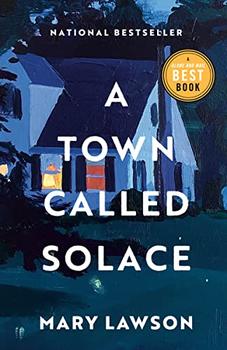Summary | Excerpt | Reviews | Beyond the Book | Read-Alikes | Genres & Themes | Author Bio

This article relates to A Town Called Solace
 In the acknowledgments at the end of her book, A Town Called Solace, author Mary Lawson writes, "The town of Solace exists only in my imagination, but the setting is very real: the vast and beautiful area of lakes and rocks and forests known as the Canadian Shield, in Northern Ontario."
In the acknowledgments at the end of her book, A Town Called Solace, author Mary Lawson writes, "The town of Solace exists only in my imagination, but the setting is very real: the vast and beautiful area of lakes and rocks and forests known as the Canadian Shield, in Northern Ontario."
A continental shield is a large expanse of land where Precambrian rocks are exposed through the Earth's crust. These formations are ancient; the Precambrian era is the earliest of the planet's geological eras, encompassing all of the time before the evolutionary development of complex life. Some of the rocks found on continental shields are thought to be as old as the Earth itself (around 4.5 billion years). Shields appear on every continent, and they are geologically stable, meaning they are little affected by tectonic events.
The Canadian Shield, centered on Hudson Bay, is the largest and best-known. It extends from Lake Superior in the south to the Arctic Islands in the north, spans most of Western Canada and extends eastward to include Greenland — an area of some three million square miles, making up about 50% of Canada's landmass. It is marked by low rolling hills and thousands of small lakes, the result of glacial erosion during the last ice age. Along with its many waterways, its vast tracts of undisturbed boreal forest make it an attractive habitat for wildlife.
 The area was home to many Indigenous tribes before the arrival of Europeans in the 16th century, and its earliest industry was fur trading. Widespread colonization took place during the middle of the 19th century as an initial wave of farmers attempted to eke out a living in the thin soil and short growing season. This was followed by a timber boom around the turn of the century as the need for building materials arose, with growth in the mining industry taking place shortly thereafter.
The area was home to many Indigenous tribes before the arrival of Europeans in the 16th century, and its earliest industry was fur trading. Widespread colonization took place during the middle of the 19th century as an initial wave of farmers attempted to eke out a living in the thin soil and short growing season. This was followed by a timber boom around the turn of the century as the need for building materials arose, with growth in the mining industry taking place shortly thereafter.
The Canadian Shield has a wealth of natural resources, with mining and logging activities making up a significant portion of the region's economy. The largest concentration of active mines in the world is located near Sudbury, Ontario, where the metals excavated include copper, nickel and gold. Enterprises also dig for diamonds, iron ore and uranium in other areas of the Shield. Pulp and paper mills take advantage of the easy availability of timber, and hydropower using the region's waterways provides for a significant portion of the country's electricity needs.
Very little of the Shield has been developed to date; nearly all of it is untamed wilderness, due to its remote location and the inability to establish and maintain businesses that don't rely on readily available natural resources. Most of the region's towns are single-industry, formed around a specific mine or mill, and are considered small- or medium-sized population centers. They are also frequently short-lived, with towns dying as mines are depleted or trees become exhausted. Only about two million people — just 8% of Canada's population — live on the Shield, a figure that is in decline. Heightened government oversight of logging and mining enterprises initiated the closure of many businesses, resulting in an exodus to Canada's larger cities.
In recent years, ecotourism has started to become a larger revenue generator for the area. With its many lakes and large wildlife population, it's become a draw especially for those who enjoy sports like fishing, canoeing and hunting. Hiking, backpacking and birdwatching are also popular activities. Winter sports, too, have seen an uptick, with cross-country skiing and dogsled riding/racing leading the way.
Canadian Shield photograph by Debbie Oppermann
Canadian Shield map, courtesy of Chalkboard Publishing
Filed under Places, Cultures & Identities
![]() This "beyond the book article" relates to A Town Called Solace. It originally ran in December 2021 and has been updated for the
June 2022 paperback edition.
Go to magazine.
This "beyond the book article" relates to A Town Called Solace. It originally ran in December 2021 and has been updated for the
June 2022 paperback edition.
Go to magazine.
Your guide toexceptional books
BookBrowse seeks out and recommends the best in contemporary fiction and nonfiction—books that not only engage and entertain but also deepen our understanding of ourselves and the world around us.